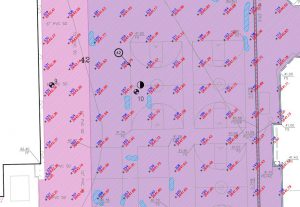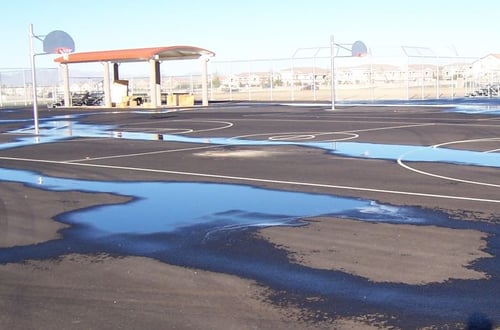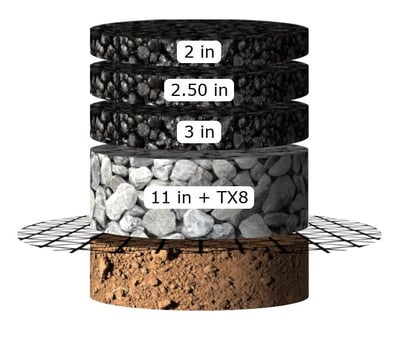 By Troy Kaiser
By Troy Kaiser
Senior Consultant
Essential elements for the development of a quality pavement rehabilitation design include pavement history, surface and subsurface drainage, traffic usage, material selection, and required strength of the pavement system. If any of these are excluded from the development of the design, the expected performance and life span of the pavement could be adversely affected.
 HISTORY
HISTORY
The first step in the development of a quality pavement rehabilitation design is to find out as much about the existing pavement system as possible. Original construction documents are a good start, but they are not always readily available or accurate. Field changes may have been completed and not documented by the contractor or owner’s representative. A better indication of existing conditions is through geotechnical exploration. Boring into the pavement and subgrade to obtain core samples provides critical details such as the type and thickness of materials installed, the subgrade soil types, and whether there are signs of water or excess moisture. Because cores provide only a snapshot of the location, the more cores taken, the more accurate the data will be.
DRAINAGE
Drainage, both surface and subsurface, must be considered for a quality pavement design. If the surface drainage is not easily confirmed, a site survey should be done to determine areas of poor drainage, which should be redesigned to drain properly. This may be accomplished by changing existing grades or installing additional drainage structures and associated storm sewer. Standing water on new pavement is unacceptable as it will cause premature deterioration of the pavement and may be an icing hazard in colder climates. If geotechnical exploration indicates moisture is present under the pavement structure, the design must include items to remove subsurface water from the pavement system. These items could include a free-draining base layer, underdrain, or a combination of the two. Subsurface water causes the subgrade and subbase to be unstable; therefore, keeping the pavement structure dry will ensure it performs as expected.
not easily confirmed, a site survey should be done to determine areas of poor drainage, which should be redesigned to drain properly. This may be accomplished by changing existing grades or installing additional drainage structures and associated storm sewer. Standing water on new pavement is unacceptable as it will cause premature deterioration of the pavement and may be an icing hazard in colder climates. If geotechnical exploration indicates moisture is present under the pavement structure, the design must include items to remove subsurface water from the pavement system. These items could include a free-draining base layer, underdrain, or a combination of the two. Subsurface water causes the subgrade and subbase to be unstable; therefore, keeping the pavement structure dry will ensure it performs as expected.
TRAFFIC
Understanding the current or planned traffic usage is very important during the design phase. Loading on a pavement varies greatly depending on the intended use. For example, the load on a tennis court is far less than the load on a parking lot for cars or a trucking area. In the design process, the load a pavement will be subjected to is used to determine the strength needed to support the load. It should be noted that although a pavement for pedestrian use (such as a walking path or running track) will have low loading numbers, the design load needs to be robust enough to support construction equipment during the rehabilitation process.
MATERIALS
The selection of materials is another key component for quality design as different materials have different strength factors and performance characteristics. For the subbase, a crushed limestone or recycled concrete may be a better option than locally available gravels. For the pavement, asphalt may be a better choice than concrete or vice versa, depending on the usage. Simply specifying a generic asphalt or concrete pavement is not enough information for a project. The specific type of concrete/asphalt mix chosen for a design is very important as each mix has different properties or additives that perform better in certain situations/climates.
 STRENGTH
STRENGTH
The basic goal of any pavement design is to construct a pavement system where the subgrade, subbase, and pavement work together to carry the expected traffic loading. This is achieved by analyzing information regarding the soil conditions and expected traffic loads as well as the performance of the selected subbase and pavement materials. It can then be calculated whether the proposed design will support the expected traffic over the desired life span. In addition to the subbase and surface materials, the designer can explore incorporating additional items such as soil stabilizer additives, subgrade fabrics, geogrid reinforcement layers, or paving fabrics for pavement structure improvements. There are several computer programs that allow the designer to simulate a pavement system’s performance using a variety of materials and thicknesses to determine the most cost-effective design that also achieves the design goals of the pavement system. During the design process, there may also be an opportunity to use in-place recycling techniques to improve the design while reducing costs. These techniques may include pulverizing the old asphalt and concrete for use as base materials and are often used in large-scale projects. They may not be cost effective or constructable for smaller projects.
There are many options when it comes to the essential elements of a rehabilitation design, and it can be a bit overwhelming if you are not familiar with the process. We hope you take the time to consider all the elements to ensure you get a cost-effective, long-lasting pavement.
